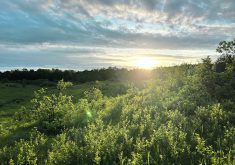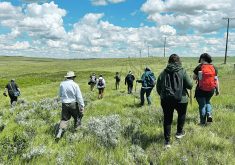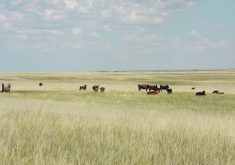The Nature Conservancy of Canada has developed a plan to protect 1.2 million acres of threatened prairie by 2030
MELITA, Man. — They might be known to humans as the “Poverty Plains,” but this windswept patch of southwestern Manitoba is rich with wildlife.
Even on a cold, late October day, faced with a harsh northwestern breeze, and with half a foot of snow having fallen over the past day, this rolling territory hosts numerous winged creatures.
A harrier hawk zips over a road, peering down for scampering rodents. A sharp-tailed grouse struts along the edge of a field, cocking an eye at the bipedal visitors passing its territory.
This is land where fancy-named prairie birds like Baird’s sparrow, the chestnut-collared longspur and the ferruginous hawk have been at home for thousands of years, long before anybody with a name like “Baird” came along to designate things in English. It is also home for a colony of burrowing owls, an endangered species.
Underneath the snow lie many more native species, both animal and vegetable. This is also the native range of grandma’s eyebrows, wolf willow, artemisia (sage), and so many more homegrown plants.
Passing by on the road, it might look like any other patch of prairie pasture, but it’s not. It’s one of the shrinking number of native pastures that still appear as most of Western Canada did before settlement. It has become a refuge for an ecosystem that is at risk of disappearing almost entirely, as crop farming income trumps cattle returns, causing millions of acres to be plowed up.

That’s the reason Nature Conservancy of Canada moved to buy this land when the farming family who had long stewarded it, protecting the burrowing owls and other natural residents, decided to sell. The conservation organization couldn’t afford to buy all the Gervin family’s land, but made a deal with the purchaser of the cropland to get ownership of this special property.
“We’re ecstatic, but also very humbled because conservation groups have known about this area and this property for a long, long time and how important it is,” said Josh Dillabough, a natural area manager for NCC in Manitoba, as he led a reporter through some of the Jackson Pipestone Prairie and Wetlands.
“This habitat is so fragmented and so rare. It’s a big win for conservation.”
It’s also a win for cattle producers because managing this natural territory will involve having cattle on the land for about 100 days a year as a crucial part of keeping the pasture healthy. The NCC sees well-managed cattle grazing as a critical part of preserving the prairie.

The two patches of land the NCC has obtained are about 1,200 acres, with wetlands in one and a meandering, intermittent creek winding through the other. That’s just going to be a tiny part of what NCC hopes to achieve with its Prairie Grasslands Action Plan, which aims to protect about 1.2 million acres of threatened prairie by 2030.
It has received financial support from Environment Canada and the U.S. Fish and Wildlife Service, but most of its money comes from individual donations from supporters.
That amount of habitat preservation might sound like a lot, but already about 82 percent of Western Canada’s native prairie has been lost, so it’s more a case of creating prairie preserves than establishing anything radical or new.
This sort of wilderness isn’t easy to spot. It looks like any of thousands of pastures in the West, lost among millions of acres of cropland, well off the main highways.
But for the native birds, animals and plant species that will get to keep using it as a permanent home, keeping this land as it has existed for centuries is vitally important, even if they won’t even realize it has happened.
















